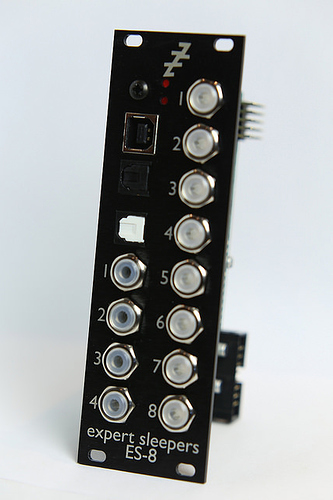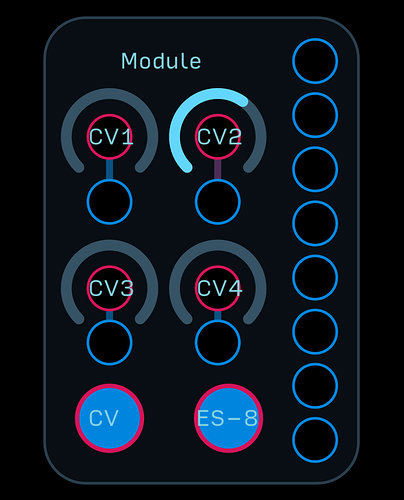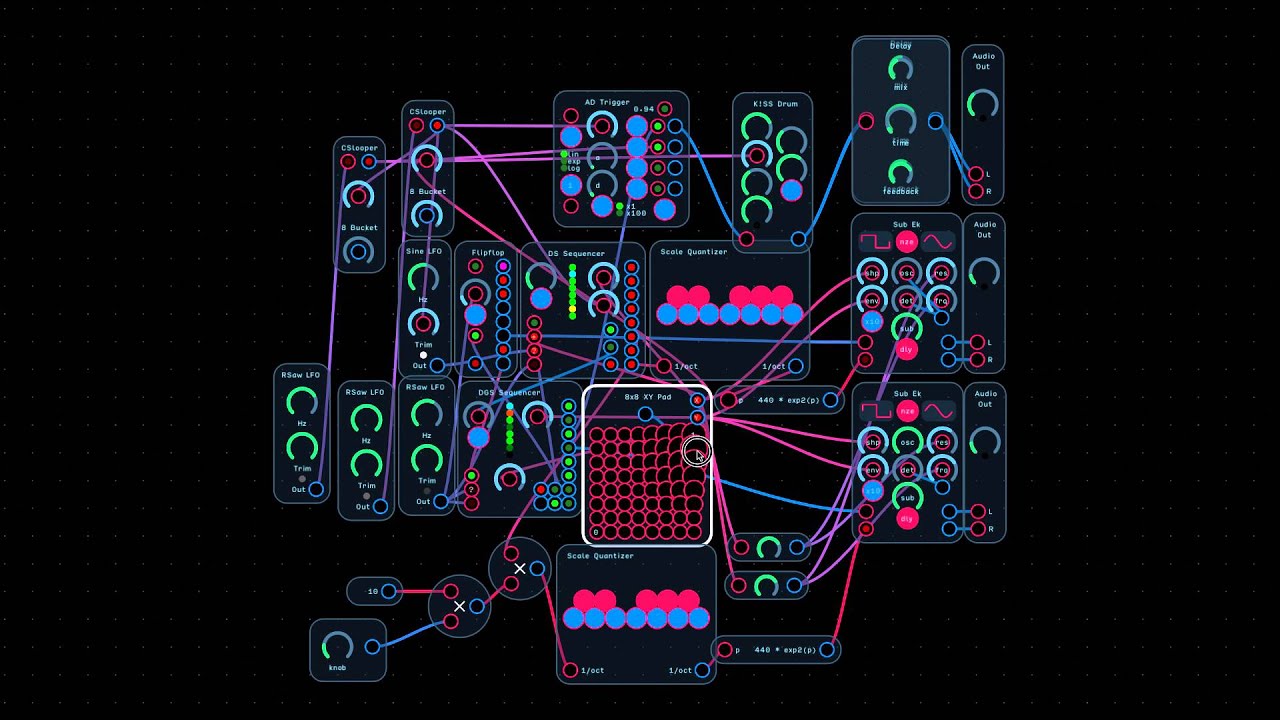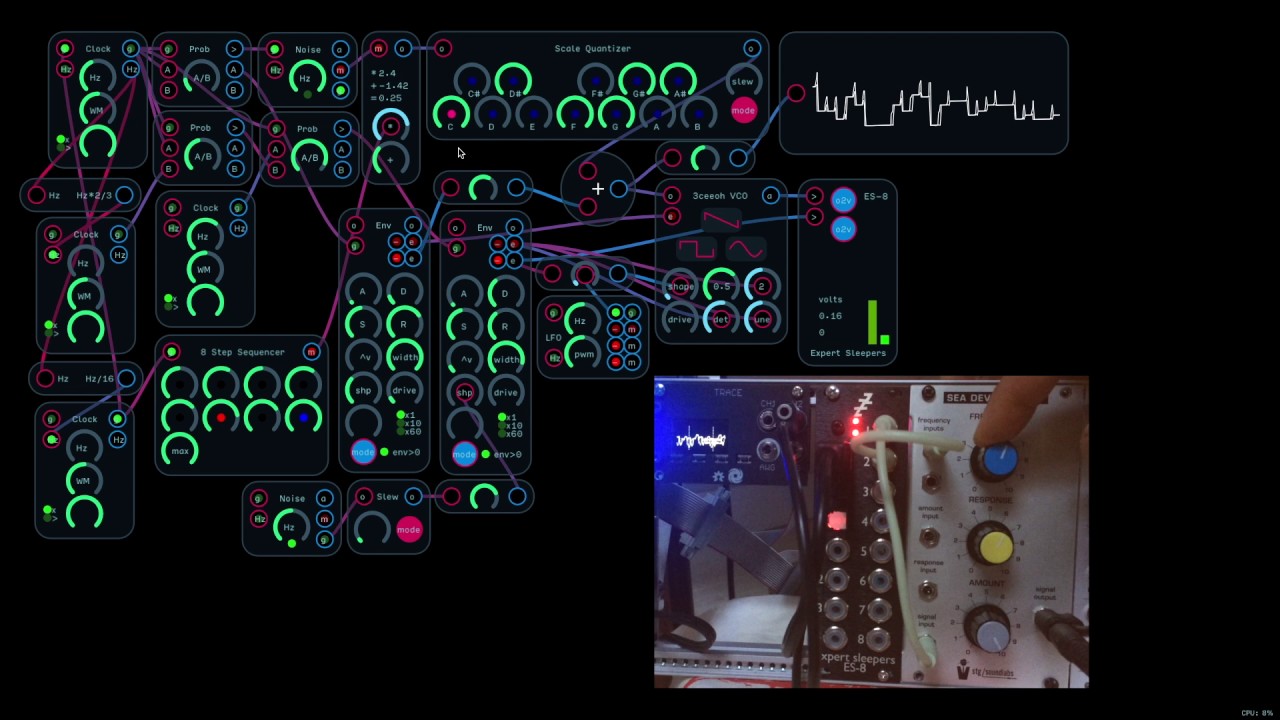Expert Sleepers ES-8 and Audulus: The Perfect Pair
Audulus is a modular synthesizer programming environment for iOS, Mac, Windows, and Linux, and it can be used in conjunction with the Expert Sleepers ES-8 DC-coupled audio interface to augment your Eurorack modular synthesizer.
Advantages of Audulus + ES-8 Hybrid System
- Economy - An Expert Sleepers ES-8 is $475. It’s an expensive module, but it is well worth the price. Why? Because once you have one and use Audulus with it, you can use your ES-8 to replicate the functionality of tens of thousands of dollars of modular synthesizer gear.
- Versatility - The ES-8 is like a blank slate - you can make it do whatever you “program” it to do with Audulus. You can think of it like a super Disting multifunction module. There are already many clones of Eurorack modules in Audulus that, when paired with an ES-8, are essentially functionally identical.
- Recallability - Analog is great for a lot of things - one this it isn’t great for is recallability - especially when it comes to sequencers. One thing that’s not so great about modular is switching quickly between two patches. Audulus and the ES-8 allows you to do this quickly and easily by merely opening another Audulus file. The way I have my modular set up, I can go through a whole set of songs, each with different drums, different routing, different oscillators and sequencers and quantizers, all instantaneously. Each song will play the exact same way every time (that is, if I want it to).
- DIY Originality - Don’t know how to DIY your own Eurorack modules with electronics? Don’t understand how to hack your digital modules with your own code? You can do the next best (and much easier) thing and create your module in Audulus. The added bonus is that if you use your iOS device, you can have a touch screen interface for your module as well! And if you have an idea that you don’t know how to translate into Audulus, we will help you.
DC Coupled Audio Interfaces
A DC coupled audio interface allows you to pass not only audio, but static offset control voltages, like gates and 1 volt per octave pitch information.
Most audio interfaces are AC coupled, meaning they filter out DC offsets. If you tried to send 1vpo signals through an AC coupled interface, it would never stay in tune.
Expert Sleepers ES-8

The Expert Sleepers ES-8 Eurorack module is a 4 input 8 output high resolution audio DC-coupled audio interface (expandable to 12 inputs and 16 outputs). Each input and output glows red for positive voltages, blue for negative, and a steady purple for audio - which, by the way, matches the Audulus red/blue aesthetic nicely.
ES-8 vs. Alternatives
While we highly recommend you use an Expert Sleepers ES-8 as your Audulus-to-modular interface, you can of course use any DC coupled audio interface, which include all of the Universal Audio interfaces.
The reason we recommend the ES-8, however, is that not many (or any I know of as of this writing) interfaces can do everything that the ES-8 can.
- iOS connectivity - immediately and seamlessly pairs with your iPhone or iPad without the need of drivers.
- Voltage Range - The ES-8 has a voltage swing of -10 to +10 volts. Not only is this a nice round number, it also interfaces very easily with the -1 to +1 output range of Audulus. This means every 0.1 interval in a signal in Audulus is equal to 1 volt. Most other interfaces only go up to 8 volts, which means each volt is equal to intervals of 0.125 in Audulus, and you are limited to 8 octaves of vpo tracking (which can be troublesome especially when doing FM synthesis).
- Convenience - The ES-8 screws directly into your rack - no muss, no fuss, no “dongle” interface with a separate power supply.
Building a Eurorack system around the ES-8 and Audulus
If you’re new to Eurorack and like the idea of a hybrid Audulus+ES-8 system, follow the steps below. If you’re a seasoned modular synthesist, skip down to the next section.
- Buy a Eurorack powered case. There are many options to choose from. I chose a small mobile rig made by Pulp Logic that fits in my backpack. I like the idea of being able to bike to a show, or to a mountain getwaway with my Eurorack system. Perhaps you’d like a larger case that has room for expansion. While many may discourage you from getting a small case to start with (such as the Doepfer Mini Case), small cases will always come in handy later, even if you move on to a larger system, because you can always use them as a “overflow” for new modules.
- Buy an Expert Sleepers ES-8. Choose from the long list of Expert Sleepers vendors and buy an ES-8.
- Decide what your first module will be, and buy it. What you buy first depends on how you want to balance the relationship between Audulus and your Eurorack. The safest bet for a first module, though, is a filter. I would suggest starting with a Doepfer filter. Doepfer has a large line of these, and each one has its own unique sound. With just a filter and an ES-8, you can create a synthesizer in Audulus that has digital oscillators, envelopes, and VCAs, but using that external analog filter can add a lot of magic to your sound. Another great first module would be a distortion, which, like analog filters, can be difficult or at least resource-intensive to model in digital form. By “offloading” the job of filtering to an analog filter, or distortion to a module like the Erica Synths Fusion Tube Mixer, you are reserving CPU time (read: computer power) for more tasks that don’t require an analog circuit to “sound” analog.
- Use Audulus to explore modular synthesis as a concept, and expand from there. You may like the idea of using a real CV sequencer with Audulus - say a big fancy one like the Klee. There is something to twisting knobs that’s really enjoyable and changes the way you interact with something. I personally enjoy the instant recall of having Audulus take care of all my sequencers, and I use my Eurorack mostly for its filters and distortion/overdrive. But maybe you like the Make Noise Pressure Points controller, or perhaps an analog delay effect from Pittsburgh Modular, and want to use those with Audulus. There’s no wrong way to do it, but it does behoove you to have patience and really think and plan what you want. ModularGrid is an excellent tool for planning your rack going forward.
Audulus and the ES-8 for the seasoned Eurorack synthesist
As someone who is established in Eurorack - in its language and its workflows, you may be wondering what Audulus can add to your modular experience. Here is a short list in no particular order of uses of Audulus you may find exciting.
- Audulus iOS+ES-8 is a touch controller. You can use it for its buttons, its on-screen keyboard. You can add extra digital knobs or triggers to modules you already have. We’re also discussing a new feature for Audulus 4 that would allow you to create your own custom XY pad controllers - XYZ controllers for devices with 3d touch. Below if a video of a “quantized” XY controller with an 8x8 grid of connection points.
- Audulus+ES-8 is a blank DIY Eurorack module. If you’re not a screens person, you can still use Audulus and the ES-8 together to create your own custom module. You can just pretend the ES-8 is a module without any knobs (or use external DC offset knobs at inputs 1-4 as knobs). With a creative combination of knobs and buttons (found frequently in 1U racks) you can basically make a Frankenstein module that uses real analog controls to control a digital program that creates real analog CVs (just like many of the, say, Mutable Instruments modules do - though they are written in text code rather than visual programming). You could make it a sequencer, a filter, a reverb, a chopped & screwed delay, an modulated clock divider - anything you can imagine. Pictured below is a [ready-to-go “blank” ES-8 module](ES-8 Audulus Module Template.audulus (78.5 KB)
) waiting for you to fill it with your “circuitry.”

- Audulus+ES-8 is a way to “demo” cloned Eurorack modules. There are many patches available for Audulus that identically (or nearly-so) replicate real Eurorack modules. If you’re wondering how that module might fit in your system, Audulus is a great way to “demo” a facsimile of the module to see if it’s something you’d like to buy. How much this works as a 1:1 analogy will depend on the model being cloned, but it’s an option. This is where all of the Eurorack clones are kept on the Audulus forum. Examining the clones, or creating one yourself, can also be a wonderful exercise in understanding the design on a much deeper level than you might if you had merely read the manual. Pictured below are a few versions of a Turing Machine that Audulus user stschoen has made.
- Audulus+ES-8 is an ultimate utility and digital VCA module. As we all know, you can never have enough VCAs. Well, with Audulus, you can never run out of VCAs. There is no explicit “VCA” module in Audulus, but you can use a Multiply node as if it were one. You can also attenuvert, active buffer, mix, modulate, amplify, compress, sidechain, cross-modulate, feedback, sequential switch, logic gate, and more. One output could be a vpo signal, another an LFO, another a sample & hold based off pink noise, another divided clock signal, convert Euro vpo to Buchla standard, Buchla to Korg, etc., etc., etc.
Digital hybrid vs. all-analog system
You may expect me to say no, but the truth is, some people’s approach modular synthesis is a philosophical rather than merely pragmatic one. I was originally attracted to modular synthesis as a way to create a kind of DIY synthesizer but selecting particular modules and putting them together to create my own custom sound. Others however feel inspired by a modular-only workflow that doesn’t involve any screens.
If you feel like hardware-only is something that excites you, then by all means - more power to you. In this world of virtually infinite choices, some self-imposed restrictions can be healthy and focus your energy to unexpected and wonderful results.
I prefer a mix of limitation and limitlessness. In one sense, I’m “stuck” with the sounds that my hardware modules make, but I can use Audulus to make them sound however I want.
How to move forward from here
This thread is a perfect place to ask questions and engage with us and other Audulus users on how to create your own hybrid digital-analog Eurorack system.
If you have a dream module you’d like to create using Audulus, describe it below, and we’ll help you make it a reality in Audulus.
If you are interested in learning how to use the Expert Sleepers ES-8 as a blank DIY module, refer to this post on the Audulus forum and the videos below.
In a future post, I’ll go in depth about my personal modular synth (pictured below) - how I picked the modules I have and the thinking behind its semi-permanent patching.






